This was published 1 year ago
Australia's best road trips: Where to experience the 'real' Australian road trip
By Lee Atkinson
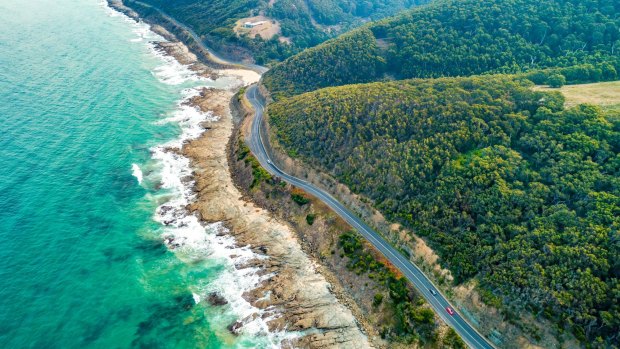
The Great Ocean Road, Victoria.Credit: iStock
Grey nomads know it. Balladeers, poets and writers such as Willie Nelson, Henry Lawson, Walt Whitman, and Jack Kerouac knew it. Even the Griswolds, when they set off to drive across the US on vacation, knew that there is nothing quite so liberating as a good road trip.
Most of us grew up in the days when the family holiday meant being bundled in the back seat and hitting the highway rather than jetting off overseas. And even if it was the same caravan park, campground, family farm or seaside holiday house that you went to each and every year, it was always an exciting adventure when you finally reversed out the driveway. Road trips – as opposed to commutes – are never just about getting from A to B, at least the best ones aren't. A real road trip is about adventure, changing your mind on a whim and the excitement of not knowing what's ahead, beyond the next bend. The most memorable road trips invariably involve getting lost, discovering somewhere new, and eating way too many sugary snacks.
With a dipping Australian dollar making overseas trips less enticing than they used to be, it’s time to rediscover the pleasures of the great Aussie road trip. There’s never been a better time to hit the road. Here’s 10 to get your engines started.
THE DRIVE
KANGAROO ISLAND, SA
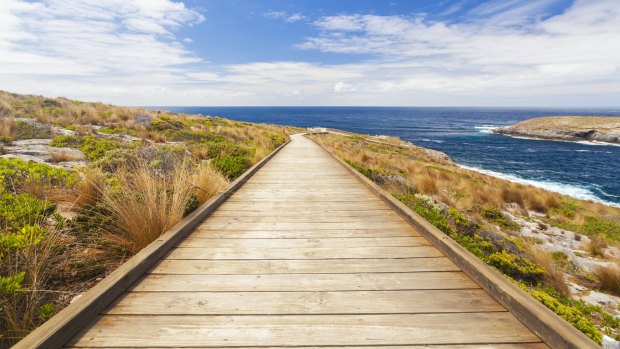
Boardwalk to the coast in Kangaroo Island, South Australia. Credit: iStock
THE DISTANCE around 660 kilometres, using Kingscote as a base.
TELL ME MORE Kangaroo Island is home to some of the most diverse wildlife you'll find concentrated in one area anywhere in Australia – fur seals, Australian sea lions, koalas, kangaroos, tammar wallabies and 254 species of birdlife. If you can't spot wildlife here then you simply aren't trying. What's more, the locals are very keen to welcome visitors back after the summer bushfires, and there are some great value deals.
NEED TO KNOW Although the bushfires in January 2020 were severe, more than half of the island, which is six times larger than Singapore, was unaffected and most businesses – wineries, restaurants, hotels and wildlife tours – are open and eager for visitors. The best way to explore the island is in separate daytrips, using Kingscote as a base. Car ferries depart several times each day between Cape Jervis on the Fleurieu Peninsula (around 90 minutes drive south of Adelaide) and Penneshaw on the island, and the trip takes around 45 minutes.
ESSENTIALS Any time of the year is a good time to do this drive – temperatures are relatively mild during both summer and winter. See tourkangarooisland.com.au; sealink.com.au; kic.com.au.
THE DRIVE
GOLDFIELDS, VIC
THE DISTANCE 209 kilometres, Ballarat to Bendigo, with detours
TELL ME MORE The goldfields of Central Victoria, around the Ballarat and Bendigo areas, were once the richest goldfields in the world. In just one decade, from 1851 to 1861, the population of Victoria swelled from 97,000 to almost 540,000. The discovery of gold left a rich legacy of grand hotels, impressive art galleries and public gardens and the historic towns look much the same as they would have 160 years ago.
NEED TO KNOW You can do this drive in a day, but allow a day or two in both Bendigo and Ballarat to explore the many museums and art galleries. Many of the shops, cafes and attractions in the smaller towns and villages such as Clunes, Maldon and Castlemaine are closed during the first half of the week.
ESSENTIALS Summers are warm and dry – most rain falls during winter, when temperatures can fall quite low. See visitballarat.com.au; www.bendigotourism.com
THE DRIVE
SNOWY MOUNTAINS, NSW
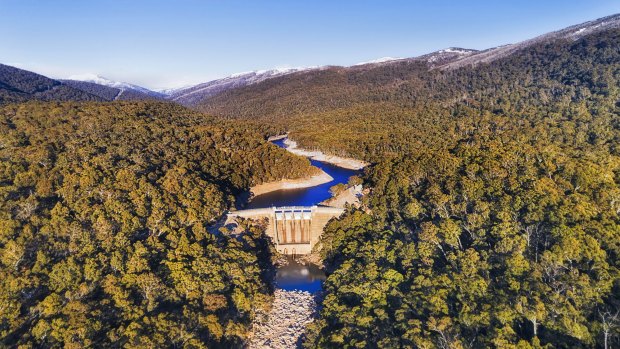
Guthega Dam in the Snowy Mountains. Credit: iStock
THE DISTANCE around 570 kilometres, looping from Cooma to Tumut via Thredbo.
TELL ME MORE See the best of the Snowy Mountains on this loop drive from Cooma that across the roof of Australia. Sheer mountainsides loom around almost every turn, alpine fields are carpeted with wildflowers and rumpled hillsides are covered in orchards laden with fruit.
NEED TO KNOW Three to four days would allow enough time to enjoy the drive and visit most things along the way, and leave time for some fishing or bushwalking in and around Thredbo – summiting Australia's highest peak, Mt Kosciuszko, is easier than you think, especially if you take the chairlift at the start. Some of the minor roads in Kosciuszko National Park are still closed after the summer fires, so check nationalparks.nsw.gov.au for updates before travelling. Snow chains must be carried on some sections between 1 June and 10 October – you can hire them at many service stations and ski hire shops in the region.
ESSENTIALS This is a drive to do in summertime, when the days are mild and dry (though the nights can get still get very cold). It is also quite spectacular during autumn when the deciduous trees in many of the towns are at their most colourful. See visitcooma.com.au; thredbo.com.au
THE DRIVE
GREAT ALPINE ROAD, VIC
THE DISTANCE 308 kilometres, Wangaratta to Bairnsdale
TELL ME MORE Snaking across the high peaks and plains of the Victorian high country this road trip provides sublime mountain scenery at almost every turn – along with plenty of great food and wine. It begins in pastoral northern Victoria, not far from the Murray River, and takes you high into the ski fields, deep into the heart of two alpine national parks and finally brings you out, a stone's throw from the coast, in East Gippsland.
NEED TO KNOW There’s lots to see and do and four or five days would give you plenty of time to explore along the way, although you could feasibly drive the full route in one long day. If you don’t want to drive all the way to the coast, loop back to Bright from Omeo via Falls Creek on the Bogong Alpine Way Road. The Great Alpine Road is fully sealed and is open all year, but the Bogong Alpine Way closes between Falls Creek and Omeo during winter. There is no fuel available at Falls Creek or Dinner Plain, so fill up at Omeo, Harrietville or Mount Beauty before heading up the mountain.
ESSENTIALS Unless you're keen on skiing, the best time to do this drive is in the warmer months or during autumn (April and early May) when the autumn colours, especially in Bright and Omeo, are stunning. See visitbright.com.au; omeoregion.com.au; victoriashighcountry.com.au
THE DRIVE
FLINDERS RANGES, SA
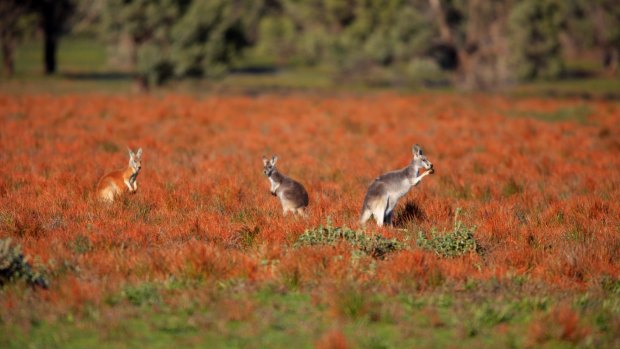
Kangaroos at Flinders Ranges, South Australia. Credit: iStock
THE DISTANCE 676 kilometres, looping from Quorn to Arkaroola via Parachilna.
TELL ME MORE The Flinders Ranges are an ancient landscape, full of weathered crags in primeval colours, mountains of rich purples and deep blues, cut through with red rock gorges and surrounded by expanses of white, yellow, red and purple wildflowers in spring. Just a half-day drive from Adelaide, this is the outback at its most scenic, and most accessible.
NEED TO KNOW Allow at least three or four days. Must sees include a scenic flight over Wilpena Pound, dining out on bush foods at Parachilna's Prairie Hotel and a 4WD ridgetop tour of Arkaroola. Many businesses are closed during January and February. While the Flinders is remote and rugged, the main roads are accessible to conventional vehicles and caravans; however, many sidetracks are 4WD only. Make sure you have a spare tyre (or two), as the rocky roads are very hard on tyres.
ESSENTIALS The best time to visit is in spring, when the landscape is carpeted with wildflowers. www.flindersandoutback.com.au
THE DRIVE
CORAL COAST, WA
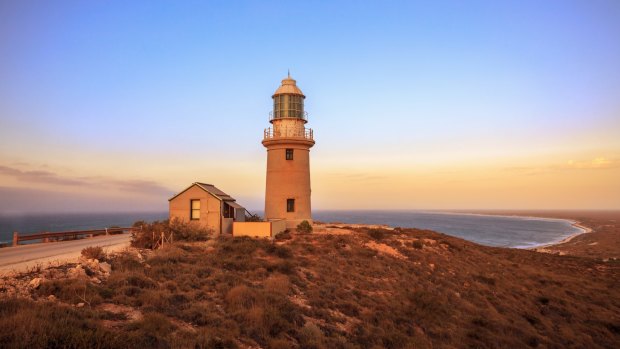
Sunset at Ningaloo Lighthouse near Exmouth, Western Australia. Credit: iStock
THE DISTANCE 1389 kilometers, Perth to Exmouth.
TELL ME MORE Red desert dunes meet an astonishingly turquoise sea on this long stretch of coastline between Perth and Exmouth that features gorges, cliffs and insta-worthy rock formations. Ningaloo Reef is every bit as magnificent as Queensland's Great Barrier Reef, with the added advantage that you can actually walk straight from the beach to the coral, as well as being home (April–early July) to the amazing whale shark.
NEED TO KNOW Allow at least a week, one way. If you don't have time to do the whole trip, just do the Indian Ocean Drive from Perth to Geraldton for beautiful coastal scenery. Between early July and late November the coastal plains burst into bloom. Roads are sealed but there are some long distances and remote sections.
ESSENTIALS Exmouth is dry and warm almost all year – perfect beach weather. See australiascoralcoast.com
THE DRIVE
BLUE MOUNTAINS, NSW
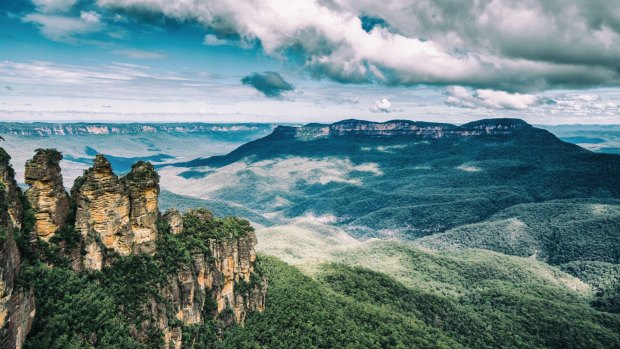
The Three Sisters in the Blue Mountains, NSW. Credit: iStock
THE DISTANCE around 290 kilometres, return loop from Sydney to Lithgow via Katoomba.
TELL ME MORE The massive ridge of mountainous wilderness known as the Blue Mountains is around two hours by car from the centre of Sydney. It's an area of dramatic mountain scenery, home to the well-photographed Three Sisters rock formation and a great place to do some bushwalking. During winter it's a great place to go to snuggle up beside a roaring fire on a romantic weekend away. In summer it's the place to go to escape the heat. In autumn it is painted with the fiery hues of the turning leaves, and in spring hundreds of private and public gardens burst into bloom.
NEED TO KNOW You can do this loop in one day, or stretch it out over two or three days and do some bushwalks – there are a lot of shorter walks in and around Katoomba and Wentworth Falls near all the scenic attractions. Roads can get icy in winter, particularly early in the morning, so take care.
ESSENTIALS The Blue Mountains region is appealing year-round. See visitbluemountains.com.au
THE DRIVE
TROPICAL WAY, QLD
THE DISTANCE 325 kilometres, Cairns to Cooktown via Port Douglas.
TELL ME MORE There are two main reasons that thousands of visitors head to tropical north Queensland each year: the rainforest and the Great Barrier Reef and you can explore them both – with or without a four-wheel-drive – on this drive from Cairns to Cooktown on one of the country's most scenic coastal drives.
NEED TO KNOW If you just drive straight to Cooktown via Cooktown and Mount Molloy, it will take less than a day, but the sidetracks on this road trip offer some of the best scenery in the country, so take your time and allow a couple of days. Summer is very wet and humid and some minor roads may be affected by flooding.
ESSENTIALS Winter is warm and sunny with little rain. See tropicalnorthqueensland.org.au
HOW TO BE ROAD READY
1. SERVICE PLEASE
Get your vehicle serviced by a licensed mechanic before you leave home.
2. POWER RANGERS
You'd be amazed how many people get stranded with a flat battery, especially if they are running portable fridges, chargers or night lights. Carry a spare and turn off appliances off overnight.
3 KEEP THE PRESSURE ON
Most of us forget to check tyre pressure. Carry, and use, a tyre gauge. Before you leave, check the tread and make sure you have a spare in good condition.
4 THE RIGHT TOOLS
A basic tool kit should include a jack, jacking plate and wheel-replacement tools, spare tyre, fire extinguisher, emergency fuel supplies if heading off the beaten track, engine oil, coolant, jumper leads and spare radiator hoses and fan belts and the tools you'll need to replace them.
FIRST AID
5. Never travel without a first-aid kit, and always carry extra drinking water.
ROAD TRIP SURVIVAL GUIDE
1. DRIVING ON UNSEALED ROADS
Many country roads are unsealed – they can be bumpy and dusty, but unless otherwise signposted are generally fine for conventional two-wheel-drive vehicles when conditions have been dry. After heavy rains they may take days to dry out.
2. TOWING A CARAVAN
Be aware of your van's height and weight – you'll often come across low-level bridges in country areas. Some bridges have a 3-tonne limit, as do many unsealed roads after rain.
3. DRIVING IN SNOW
Snow chains must be carried on certain roads between 1 June and 10 October in alpine areas of New South Wales and Victoria. The best option is to hire chains, which are widely available in these areas in winter. Ask for a demonstration of how to correctly fit your chains before you leave.
4. DRIVING IN THE OUTBACK
Ensure you are carrying enough water, basic spare parts, food and fuel. Petrol stations in remote areas are not often open after hours or at weekends. If you do get into trouble, do not leave your vehicle. Station properties are often unfenced, so watch for cattle and wildlife on roads and avoid driving at night. Always leave gates as you found them.
5. GIVE ROAD TRAINS A WIDE BERTH
Slow down and, if there is an escort vehicle, watch for signals. If you move off the road, reduce speed and watch for guide posts and soft edges.
6. TAKE THE RIGHT MAPS OR A GOOD SAT NAV
fighting over which is the right way to go is a major cause of holiday (and marital) breakdown.
7. PACK IT IN
Don't overload your car or carry unrestrained items in the back seat – even a flying book can cause serious injury in a crash. If it won't fit in the boot, don't take it. If you're travelling in a wagon or 4WD, install a cargo barrier.
8. ROAD TRIPPING WITH KIDS
don't be too ambitious in terms of how far you think you can get in one session, allocate plenty of time for rest breaks and plan them in advance. Take the time to get off the highway and stop at a park with a playground or swimming pool rather than a roadhouse.
9. KEEP KIDS AMUSED
Pack toys and games but avoid books if your kids are prone to motion sickness and anything hard, sharp or tricky to clean if spilt (or doodled) on upholstery. Listen to an audio book or podcast some children's stories. Don't underestimate the power of old-fashioned games like I-spy, spelling bees, word games, 'who am I' and so on – the internet is full of quirky suggestions. If all else fails, portable DVD players are a lot cheaper than they used to be and most run via the 12-volt outlet in the car – don't forget headphones.
10. PACK A SURVIVAL BAG
Put everything you might need, like a change of clothes, towel, swimmers, jumpers, torch, even pyjamas, in a bag to carry in the car to save repacking the boot everything you need something.
FIVE MORE CLASSIC DRIVES
1. GREAT OCEAN ROAD, VIC
One of the world's greatest coastal drives past beaches, along sections of cliff-top road, through beautiful sections of rainforest and of course, those famous rocky sea stacks known as the Twelve Apostles.
2. ACROSS THE NULLARBOR
Experience outback Australia's vast open space on the 3000 kilometre drive from Perth to Adelaide across the famous Nullarbor Plain on one of the longest, straightest, flattest pieces of road in the world.
3. GIBB RIVER ROAD, WA
Traversing one of the most isolated corners of the country, Australia's most celebrated outback track, The Gibb River Road, is a road trip for those that like wild adventures.
4. WATERFALL WAY, NSW
Wind your way through some of the most beautiful rainforest and gorge scenery in Australia, between Coffs Harbour and Armidale in northern NSW.
Lee Atkinson is a self-confessed road trip junky who loves getting away from the crowds in some of Australia's most wild and remote places. She has been writing about her adventures on and off the road since 1991. Ultimate Road Trips: Australia, which highlights 40 of the best driving holidays around the country, is her 14th book. It's published by Hardie Grant Travel, rrp $39.99.
Sign up for the Traveller Deals newsletter
Get exclusive travel deals delivered straight to your inbox. Sign up now.